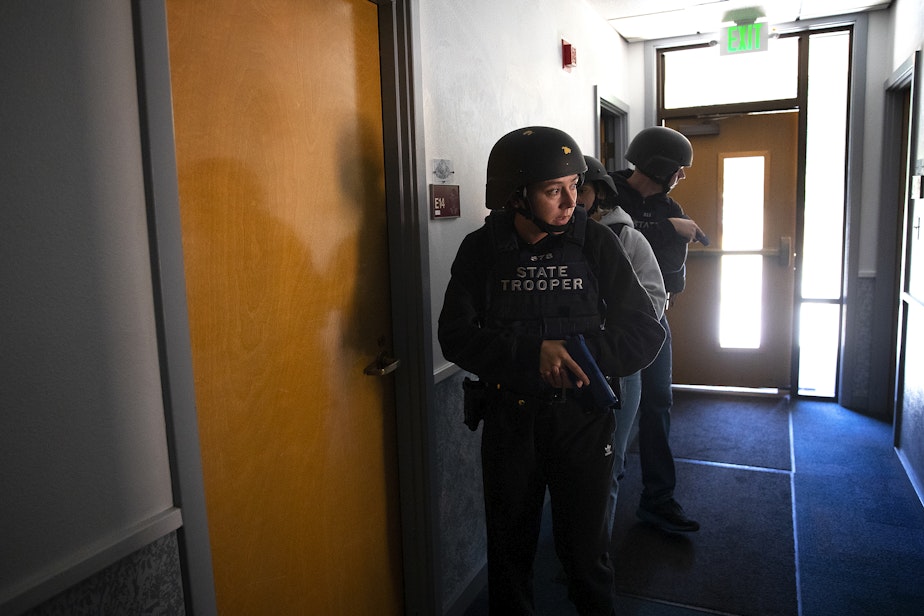More mentors, better facilities, gear that fits. WA police departments are upping their game to recruit more women
It’s estimated that just 12% of police officers nationwide are women. At 11%, Washington state lags below that already low number.
Several law enforcement agencies across the state have signed on to a goal to increase women in the ranks. They’re recruiting women by offering strong mentorship programs and better-suited gear and facilities, among other strategies. But so far, success is mixed, and larger agencies especially continue to struggle.
Participants in the national 30x30 initiative aim to have 30% women officers on staff by the year 2030. Backers point to research indicating that women in policing generate fewer complaints, fewer lawsuits, and are less likely to use excessive force.
Eight agencies in Washington state have signed on to the hiring goal —Kent, Lacey, WSU Pullman, Richland, Seattle, Tacoma, Vancouver, and the Washington State Patrol. But amidst a national shortage of police candidates, progress is slow, especially for bigger agencies.
The Seattle Police Department is being sued by multiple women officers for sexism and discrimination. Interim Chief Sue Rahr said part of her task is to get to the bottom of some of the anonymous feedback that women at SPD provided so far as part of the 30x30 initiative. They described instances of discrimination and exclusion, with one person calling the agency a “good old boys’ club.”
“Obviously we don’t know who made the statements, which is appropriate," Rahr said. "But [we need] to make sure we’ve got something in place to avoid those negative experiences from happening.”
Rahr said when she was a pregnant deputy at the King County Sheriff’s Office years ago, her supervisors weren’t sure how to adapt. She asked them to treat her the way they’d treat an officer with a broken leg — take her temporarily off patrol.
“We’ve gotten better, the system has really begun to adapt to that part of becoming a parent,” she said. “What the system hasn’t done for any of us, male or female, is to recognize the pressures that are on parents of young children.”
Rahr said she wants to explore flexible, part-time hours (something now permitted in law enforcement under state legislation she advocated for) and child-care assistance to make SPD a top destination for any officers facing parenting pressures.
Women make up 14% of the sworn staff in Seattle. They’re even more rare at the Washington State Patrol, at just 9%. That agency had its first female troopers in the 1970s, after it eliminated a 6-foot height requirement for all applicants.
Recruiting Sergeant Johnna Batiste said part-time hours just aren’t an option at the State Patrol. But she said she did feel supported there as a new parent.
“I am lucky in the fact that I have an extremely supportive village,” Batiste said. “I started the patrol, I was not married, not a mother. I can say now I worked the road as a mother, maybe too much information but I worked the road as a breast-feeding mother. Like, it can be done.”
Batiste said the patrol’s vigorous recruiting efforts have yielded a current class in which nearly a quarter of the 38 cadets identify as women, a new record.

One of them is 27-year-old Claudia Travis. Travis was a likely prospect in some ways. Her father and grandfather worked in law enforcement and she worked a civilian job at the State Patrol. But Travis ruled out being a deputy, until she rode along with a female officer, and they bonded.
“I’ve seen many females in law enforcement throughout my life – I just, I was a kid and they were an adult,” Travis said. “So I think I never got to just have those casual conversations to be like, 'Wait, we’re the same.'”
Sponsored
She said another formative experience has been learning physical tactics from a female trainer at the state patrol’s academy in Shelton.
“That probably was one of the most intimidating things for me, actually going hands on with somebody when I’m smaller, and I think getting to see how she does it, and get that perspective of, 'Oh, it works!'”
Another agency with the 30% hiring goal is Lacey, Washington, next door to Olympia.
Chief Robert Almada joined Lacey PD five years ago. Coming from Santa Monica, he said he took having women in the ranks for granted.
“I was a little surprised, frankly, that there wasn’t the level of participation by females in law enforcement that I’d seen in Southern California," he said.
Almada said when he sent his deputy chief to a symposium on women in policing held in Tacoma last year, that staffer was the only male representative from any law enforcement agency.
Almada said he sees a benefit to having officers of different races, genders, and life experience. He said in one recent example a young man was trashing a local McDonald’s restaurant and assaulting employees. A female Pacific Islander officer was uniquely able to head off a worse confrontation.
“She talked him into handcuffs and into sitting in the back of a patrol car with no use of force,” Almada said. “Anywhere else that would have been a knockdown drag-out fight more than likely.”
Almada said he’s sought to attract female recruits to his roughly 70-officer department by eliminating any disparities in their locker rooms or other facilities, and making sure gear is fitted appropriately, not one-size-fits-all. His agency also goes to testing events to woo promising candidates in person.
It’s paying off. Almada said he expects the Lacey Police Department to meet the 30% goal long before the deadline in 2030.
Sponsored
For other participants, results are mixed. Big agencies like Seattle and Washington State Patrol have fewer officers, male and female, than they did five years ago. But smaller cities like Richland, Vancouver, and Tacoma appear to be making significant gains, in annual tracking compiled by the Washington Association of Sheriffs and Police Chiefs.



